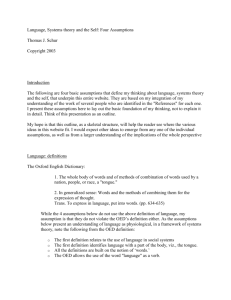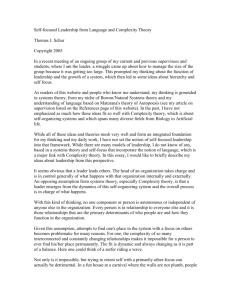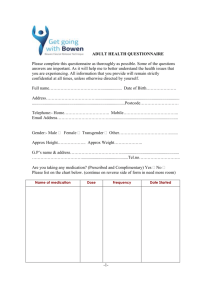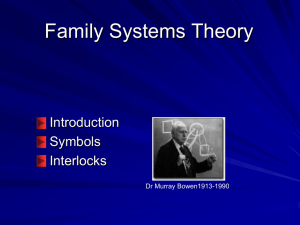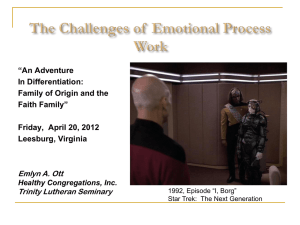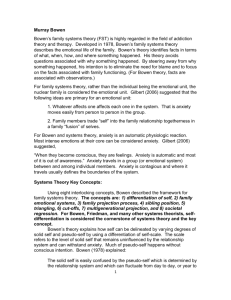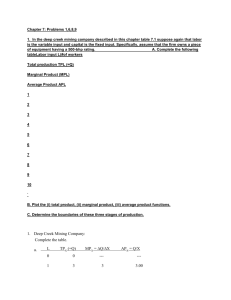File - Emergent Ideas
advertisement
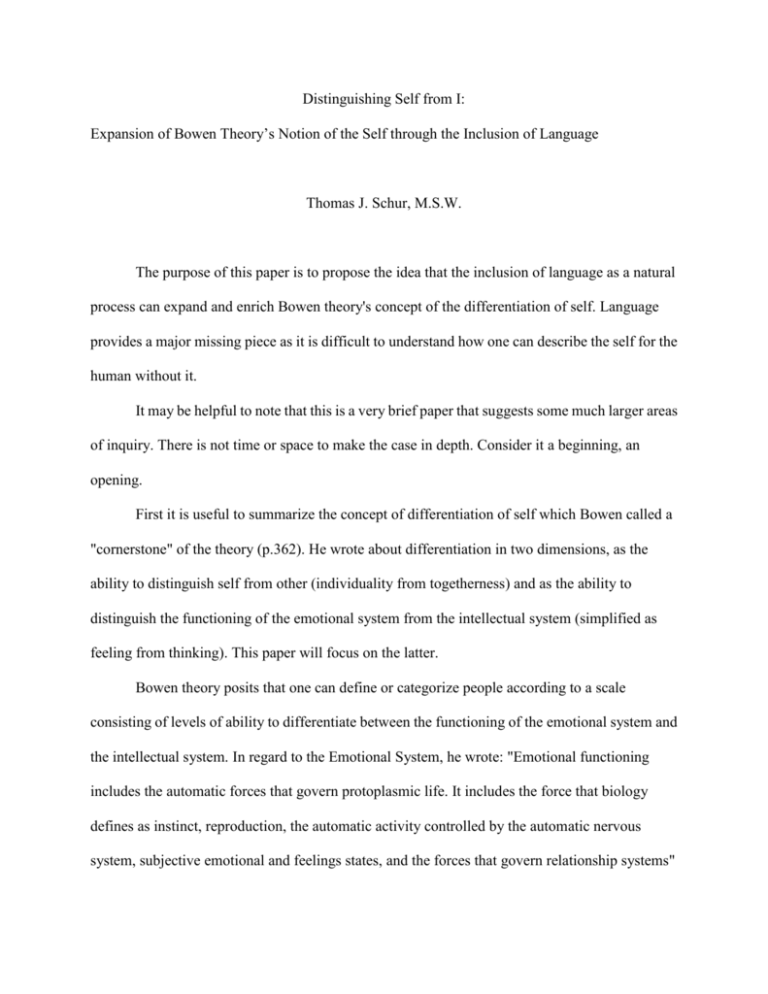
Distinguishing Self from I: Expansion of Bowen Theory’s Notion of the Self through the Inclusion of Language Thomas J. Schur, M.S.W. The purpose of this paper is to propose the idea that the inclusion of language as a natural process can expand and enrich Bowen theory's concept of the differentiation of self. Language provides a major missing piece as it is difficult to understand how one can describe the self for the human without it. It may be helpful to note that this is a very brief paper that suggests some much larger areas of inquiry. There is not time or space to make the case in depth. Consider it a beginning, an opening. First it is useful to summarize the concept of differentiation of self which Bowen called a "cornerstone" of the theory (p.362). He wrote about differentiation in two dimensions, as the ability to distinguish self from other (individuality from togetherness) and as the ability to distinguish the functioning of the emotional system from the intellectual system (simplified as feeling from thinking). This paper will focus on the latter. Bowen theory posits that one can define or categorize people according to a scale consisting of levels of ability to differentiate between the functioning of the emotional system and the intellectual system. In regard to the Emotional System, he wrote: "Emotional functioning includes the automatic forces that govern protoplasmic life. It includes the force that biology defines as instinct, reproduction, the automatic activity controlled by the automatic nervous system, subjective emotional and feelings states, and the forces that govern relationship systems" 2 (pp. 304-305). These systems are very old and primary and essential for survival, and so it is a misunderstanding to equate emotional system here with feelings. Bowen described a feeling as: "...the derivative of a deeper emotional state as it is registered on a screen within the intellectual system" (p. 305). The intellectual system then refers to the functioning of the higher processes of the human brain, primarily the cortex. For Bowen a major issue was the amount of fusion between the Emotional System and the Intellectual System. It is generally accepted that one of the major features of the human brain that differs from the brains of other species is the ability to abstract and reason, which is primarily a function of the cortex. This operation of reasoning is done through language. Therefore the ability to distinguish the processes of the emotional system from the intellectual system in differentiation has to involve the use of language as one abstracts about one's own functioning and that of others. However, it is not enough to include language as part of understanding the ability to distinguish the emotional from intellectual systems today. This could be rejected by Bowen as violating the consistency with Bowen theory as a natural systems theory, because it could be said this notion of the inclusion of language comes as an abstraction "from the mind of man," applied to the theory without being able to observe it in nature. Here Humberto Maturana, a biologist, offers the hypothesis that language has been an essential element in the evolution of the human brain. Maturana's hypothesis is that the emergence of language in humans is related to "their history as social animals in close-knit interpersonal relationships, associated with collecting and sharing food" (Maturana & Varela, p. 218). The basic idea is that humans were able to have a unified social group that could function without the need for continual physical interactions. They could collect food and with hands free, now with bi-pedalism, and carry it back to share with others. Additionally, with non-seasonal sexuality males and females could bond more permanently 3 so that males could be part of the rearing of the young. He speculates that this increase in socialization fits with the increased capacity to coordinate actions and thus cooperate, by reflecting upon reflections. Maturana's definition of language is the linguistic coordination of the linguistic coordination of action. An example is two people approaching each other on a sidewalk. As each coordinate their action in this encounter by distinguishing where his/her body is in relation to the other and signaling to one another, Maturana calls this linguistic coordination. As a person actively says to the other "You go here and I will go there" this is reflecting on the reflection, coordination of the linguistic coordination, or language. In this way Maturana sees language as having provided a way for humans to increase the ability to cooperate, and expand the domains of their interactions, as they could continually reflect on their reflection, which he sees in present day human functioning. Maturana then takes this one step further and that step, this author maintains, makes a direct connection with Bowen theory. Maturana hypotheses that as these early humans reflected on their reflections, they ultimately reflected on this process itself, which led to a distinction of the self as an object, which he says is the experience of mind or self-consciousness (pp. 222, 231). Bowen presumes the existence of the self and goes on to describe levels of differentiation of that self, without talking about how awareness of that self exists in the first place. Maturana provides a hypothesis that can explain how the self comes to be. On the other hand, Maturana does not relate to variations in this self that Bowen has focused on as a major part of his model, especially as that variation is a function of anxiety in the emotional system. Simplistically stated, Bowen leaves out language, and Maturana leaves out anxiety. If these reciprocal omissions are integrated, then language is seen as an essential vehicle for the existence 4 of the self, and that process is seen as a crucial part of human adaptation as a social species. With this integration then, variations in the levels of integrity of that self in the social environment (i.e. different levels of differentiation) may reflect different levels of adaptability leading to speculation about evolution selecting for higher levels of this adaptability. Now this paper will go on to develop a tool for working with this integration of self and language, and apply it to the notion of defining different levels of differentiation. Bowen made a distinction between what he called the pseudo self and the basic self. Pseudo self refers to that functioning of the human where he or she yields integrity by negotiating with others more automatically as the anxiety in the system increases. From Pseudo-self one focuses primarily on relationships and on ways to adapt oneself to reduce the experience of the anxiety. When operating from basic self, the person focuses more on oneself and tolerates the anxiety to act more on principle. Of course this notion of pseudo self and basic self correlates with levels of differentiation. For people who function at lower levels of differentiation the pseudo self predominates as he or she is less able to distinguish the processes of the emotional system from those of intellectual system. They will act more impulsively as they focus intently on others, to do what calms down the anxiety even if it is against their better judgment. At higher levels the basic self is dominant as people can focus more on self and use their ability to reason in the face of anxiety to take action based on sounder judgments. This paper suggests the use of two words to distinguish the pseudo-self from the basic self. From this point on, "I" will refer to pseudo self and "Self" will refer to basic self. There is a rationale for the selection of these words. The idea is that I connotes a reductionist sense of that person who could be thought of as separate from a system, often identified with one's body. This pull toward reductionism is especially pronounced when it refers to oneself experiencing the 5 anxiety in a system, as one wants to escape the notion that he or she is an integral part of that system. On the other hand, Self connotes a more generic sense of self awareness that, while being distinct from others in the system, is part of a system of other "selves." It is more difficult to conceive of other "I's." This paper hypothesizes that how one conceptualizes him or herself and expresses that in language both to him or herself and with others, may be part of the assessment of the level of differentiation The two extreme ends of the scale could be described as follows. I. One refers to self more as a separate entity looking to connect with other separate selves or the outside world as a whole. There is an emphasis on one's identity defined in contrast to others so as to create a sense of uniqueness. At the same time there is anxiety about connectedness and so the talk is dichotomized into either being included or excluded. The overall perspective is narrow and uni-dimensional as it always is from the reductionist viewpoint of "I." There is an inability to think in terms of systems, with a primacy on the rights of individuals. There is a linear assumption one can change the other. From this position there can also be talk of "We" which assumes the same reductionism where this group of separate I's can be connected and have an identity, as they are distinct from others, namely "them." Self. Self is referred to as part of something larger where the connection with others is presumed, not something to create. There is a sense of one's identity that is always embedded in a context. One only stands out in relation to a background, which itself is continually changing with the predictable and unpredictable events in life. Then the talk is about how to adapt to these continual changes, with the major emphasis on the self in relationship than on the other in relationship. The overall perspective is large as it is less reductionist, so that one can see multiple connections within systems and between larger systems. There is a presumption of the legitimacy 6 of all the components of a system that is a given and does not have to be maintained. Change is seen as complex and in terms of a systemic balance. The focus then is on changing self as part of the system not on changing the other. Talk of We is a statement of a set of relationships that can be distinct from a background of others but it is presumed to be part of the systemic balance, not a static group entity. One can also describe these differences between I and Self in general terms by the different use of language associated with each of the variables used above to distinguish I and Self. Certain words emphasize separateness, while others allow more contact and availability. Some statements define positions that require a bottom line rigidity to engage with people, while others convey a strength that flexes with the responses of others. Some talk implies a refusal to look at oneself instead concentrating on the other, while different kinds of talk allow the possibility of self focus. Some ideas insist on the correctness of that person's perspective, while other ideas reflect a toleration of multiple perspectives without yielding one's own. More specifically, beyond the use of this I/Self tool as a means of assessment, it may be possible to go further and work with it in practical ways to experiment with modifying one's own functioning. This practical aspect involves deliberately using different expressions in language to manage one's anxiety in a system in less reactive ways. The following are some very simple and general rules that may serve as a guide in this experiment. These rules are not intended to have a linear effect on other people or on self. They are disciplined steps first to initiate change in the predictable interactions, and then to return to, as a grounding or reference point in the ongoing recursions over the long-term. The effort is to change the coordination. An example of two people in conflict is used to demonstrate each of the rules. 7 (While some of these rules may be familiar to people already working on differentiation in their family, the dynamics of language may not be). Self-referential talk. - Avoid statements that begin with "You. ("You are always so angry.") - Avoid statements that begin with "We." ("We think you are wrong.") - Work toward making "I" the subject of statements to others and to self. ("I get angry when you are angry.") - Then, most importantly with this rule and the following ones, maintain this grounding in self when confronted with "You" statements in response by continuing to respond with "I" statements. (In this framework I-statements are actually self statements as the perspective is one of being grounded in a focus on oneself and not the other) Relationship talk If one's general pattern is to distance when anxious: - Avoid distancing comments. ("There seems to be no point in continuing this argument.") - Find words to stay included. ("I'm getting lost in this argument. Please tell me again what you want.") It is often helpful just to keep talking. If one's general pattern is to pursue when anxious: 8 - Avoid provocative comments that draw one further into the interaction. ("You have to tell me why you are so angry with me.") - Find words that define boundaries without cutting off. ("I am going to be quiet, but I am still here and listening.") It is often helpful to just stop talking. If one's general pattern is to presume limitation (reactive pessimism): - Refrain from critical, self-limiting remarks. ("In most arguments I am usually wrong anyway.") - Find words that assume okness. ("I do have a legitimate point here even if you do not agree with it.") If one's general pattern is to presume potential (reactive optimism): - Refrain from uncritical, self-expansive remarks. ("When we argue, you never seem to be able to understand what I am saying.") - Find words that allow limitation. (I am concerned when people do not understand me.") In conclusion, it is essential in this experimenting to not lose the systemic perspective about language that is Maturana's, and also a major foundation for this paper. Language is about coordination and it is a constantly recursive looping of reflection about the coordination, where that reflection becomes coordinating itself. Capra in his Web of Life cites an example of coordination (pp. 287-288) from Maturana and Varela's book, The Tree of Knowledge (pp. 9 194-195) in the mating song of some African parrots. With little visual contact through the dense forest, they do their mating ritual with a common song. It seems each bird is singing its own song until upon closer observation, it is clear it is a duet, each expanding on the other's phrases. In addition, this melody is unique to each pair and is not passed on to offspring. This is linguistic coordination. If they could talk about their melody that would be formal language. Humans can and do talk about their "duets." The framework proposed in this paper for experimenting with different words may provide one way to change some human "melodies" over time. References Bowen, M. (1978). Family therapy in clinical practice. New York: Jason Aronson. Capra, F. (1996). The web of life. New York: Doubleday. Maturana, H.R. & Varela, F.J. (1987). The tree of knowledge. Boston: New Science Library. Distinguishing Self from I: Expansion of Bowen Theory's Notion of the Self through the Inclusion of Language Thomas J. Schur Abstract Schur This paper will present the hypothesis that the self for the human does not exist independently of language, based on the assumption that language is part of human evolution. Bowen described his theory as a natural systems theory and wrote about the use of higher levels of the human brain as reflecting higher functioning and more adaptability. This paper assumes that language is one of those higher functions and speculates that it is part of the human's survival through evolution. If this is true, one should be able to use language patterns to assess different levels of differentiation of the self within the framework of Bowen's general scale. If this is possible, the incorporation of language as a natural process could expand Bowen's concept of the differentiation of self. The paper will first briefly describe language as a natural, recursive process, drawing from the work of the biologist Humberto Maturana. His notion of the emergence of self consciousness in evolution is the basis for the link with Bowen's notion of the self. The paper will then describe specific uses of language as they reflect different levels of differentiation according to Bowen's scale. Here the framework for presenting the use of language in the process of the differentiation of self will be that of distinguishing "I" from "Self." It will be suggested that "I" corresponds to Bowen theory's "pseudo-self" and "Self" to "basic self." Finally, the paper will address the possibility of using language itself to manage anxiety in a family in less reactive ways.
